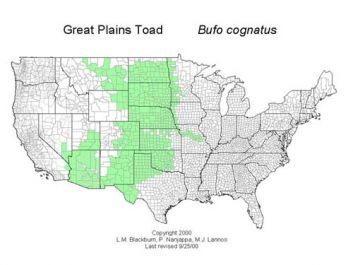Wyoming's Amphibians

Project Navigation
WYOMING'S AMPHIBIANS

This important characteristic of amphibians is partly what makes them different from reptiles. In addition to not spending part of their lives in water, reptiles also lay eggs, which hatch into young that look like smaller versions of adults - in other words, reptiles don't go through metamorphasis like amphibians do (see the life cycle diagram below).
Wyoming has 3 types of amphibians from 2 orders (download or buy the identification guide here!). Frogs and toads are in the order Anura (meaning "without a tail") and salamanders are in the order Urodela (meaning "tail evident").
Amphibians have permeable skin, which allows them to both absorb and lose water and gasses (such as oxygen) through their skin. This allows them to “breath” through their skin.
Because of their permeable skin, however, they also dry out easily and, therefore, must be able to replace or conserve water. Many amphibians do this by living near water or in moist environments. Others have adapted behaviors to help them conserve water, such as burrowing into mud or moist soil during dry periods.
Learn more about conserving and protecting Wyoming's amphibians.


Amphibian eggs are soft and jelly-like and also dry out very easily. Therefore, most amphibians return to the water to lay their eggs.
A typical life cycle for a frog or toad begins with males and females congregating near water. A male will grasp a female (this action is called amplexus) and fertilize eggs as she lays them. Frogs typically lay eggs in clusters (egg masses) either attached to plants under water or floating freely, depending on the species. True toads lay strings of eggs underwater.
Tadpoles hatch from eggs. Tadpoles are aquatic, have gills and tails, and feed on algae. As tadpoles grow they undergo metamorphosis, first developing hind legs then front legs. Eventually they lose their tails and gills, develop lungs, and emerge from the water to begin the terrestrial phase of their life.

LIFE CYCLE: SALAMANDERS
Salamanders typically have a life cycle similar to that of frogs and toads, but certain salamanders are able to alter or suspend metamorphosis depending on environmental conditions. Click here for more detailed information on the life history of Wyoming’s only salamander, the Tiger Salamander (Ambystoma mavortium).
WHERE AND HOW THEY LIVE IN WYOMING

High elevation mountain species have adapted to the severe cold of winter. Some hibernate during winter in deep burrows below the frost line or next to flowing ground water where temperatures stay just above freezing (e.g. Boreal Toad). More aquatic species (e.g. Columbia Spotted Frog) hibernate underwater in deep ponds or flowing streams where the water does not freeze solid in winter. Still others (e.g. Wood Frog) hibernate in logs, duff, or crevices that provide some insulation but not enough to prevent freezing. These species are capable of freezing almost solid during winter. When spring comes, they thaw out and resume normal activities.
Some of Wyoming’s amphibians (e.g. spadefoots) inhabit environments that are extremely dry most of the year, such as playas and dune ponds. These areas only hold water for a brief period each year, or briefly ever couple of years. Spadefoots keep from drying out by hiding in deep burrows and estivating (going dormant) for most of the year, only to emerge and breed when weather conditions are favorable.
WYOMING'S AMPHIBIAN SPECIES
Wyoming is home to 5 frogs, 6 toads, and 1 salamander. Click on a species to learn more.


